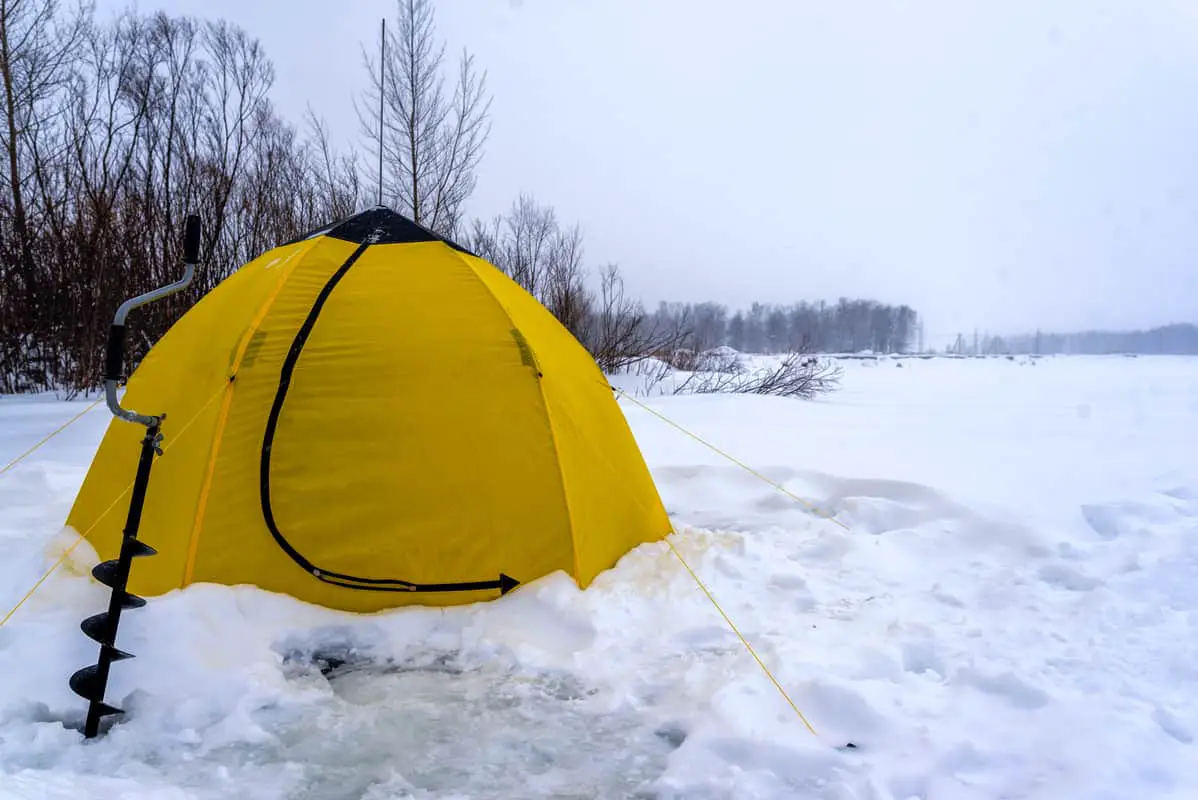For me, the best thing about using a shelter when ice fishing is the ability to get out of the wind! If you don’t have an ice fishing shelter, there are a few things you can do to use an inexpensive pop-up tent for an ice shelter!
Popup tents can be used for ice fishing with the proper modifications. Use ice anchors to secure the tent against the wind. Cut out a section of the flooring to fish through. Bank snow around the tent’s base to keep the wind from underneath and use rubber floor tiles to insulate the floor.
When fishing on a frozen lake, using a tent can be the difference between going home empty-handed and remaining a few extra hours! The extra time can have you bringing home the fish!
Ice fishing shelters can be cost-prohibitive for many people just starting out. Hub, or pop-up shelters, can range in price from $100.00 to $600.00 and higher! Flip-over shelters can be as high as $1,500.00 for a four-person shelter!
But there is another option! You can easily convert an inexpensive popup tent into a workable ice shanty with the proper modifications! Let’s take a look at the best way to do this!
Which Tent Is the Best To Use for an Ice Shanty
If you’re like me, and I think you are, you probably have one or two small tents lying around the garage from previous hikes or campouts! And most likely, it’s a small dome tent like the one pictured below.

Over the years, dome tents have taken over the tent market as far as the smaller tents are concerned. And for good reasons! They are inexpensive, small, easy to carry, simple to set up, and most importantly, they set up fast!
When fishing by yourself, I recommend a two-person tent for the extra room to provide for your fishing gear inside. If you’re fishing with a couple of buddies, then choose a dome tent that will sleep 4-6 persons.
To sleep overnight in an ice fishing tent you’re going to want to look into other options.
Keep in mind dome tents are not as strong or insulated as many of the ice fishing-specific shelters are. So you will have some give and take when using a tent.
You may also want to consider using a hunting blind for an ice fishing tent. I have a few friends who have gone this route!
If you’re going to use a regular tent to ice fish from, choosing a dome tent is the best option!
Securing Your Tent Against the Wind
The biggest threat to any ice shack when on the ice is the wind! When you’re sitting out on an open expanse of ice, there are no windbreaks like trees to shield you from the wind.
If the wind is really bad, I try to find a sheltered bay to fish and fish on the bay’s quiet side if at all possible.
A lightweight dome tent is no match for winter winds on a lake! So you’re going to want to secure it the best you can!
The best way to secure your tent is to use ice anchors. I would not go below a minimum of three ice anchors and place them in a triangulated position around your tent.
Placed in such a position your tent won’t shift as much when the wind comes from a different direction.
To reinforce your shelter from blowing away with the wind, I’d recommend using four ice anchors. With the additional fourth anchor, your tent should be almost bombproof to everything except a gale force wind!
The best ice anchor I’ve used over the years for all my popups and flip-over shelters are the Eskimo Ice anchors.
The handles are large enough you can quickly turn them into the ice with your gloves on. The screws are aggressive enough with enough of a point to bite into the ice quickly and securely. They also come in a tie-down kit complete with straps too if you need them!
There are optional anchor drill adaptors you can use with your electric drills to drive the anchors into the ice too.
Removing a Section of Floor To Fish Through
When using a dome tent to create an ice fishing shelter, you must cut a hole through the floor so you can fish through the ice, right?
Here’s the thing you want to keep in mind when cutting through the floor of your tent. Dome tents use flexible poles to tighten and hold your tent up. When placed into the tent’s sleeves, they create tension against the floor to keep the tent up!
If you cut too much flooring out, there isn’t much to hold your tent up. So just cut where you need to place your ice holes. If you need more room for additional people to fish, leave at last a minimum of 6″ (six inches) around the edges of your tent!
The six inches around the edges will give the poles something to pull against. And by having the strip of material there, you will not hurt the pole system’s integrity. The more material you can leave, the better!
Insulating Your Ice Tent From the Wind
A dome tent is often made from a thinner material than the ice fishing shelters, and they aren’t insulated like some of them either. So it would be best if you did what you could to improve heat retention.
The best way to do this is to “bank” the tent with snow! Using your feet or a shovel, kick or scoop snow up and around your tent along the bottom. What this does, it keeps the wind from entering underneath your tent!
When you keep air from entering into your shelter, you also keep warm air from leaving! By doing this, you can efficiently use a small portable propane heater to heat your tent space!
Keep in mind, when you do bank your tent with snow, there will be less light passing through the ice where you’re fishing. If you want more light to come through so you can see the fish while sight fishing, remove some of the snow around your tent.
Keeping Your Feet Warm on the Ice
As of the last couple of ice seasons, major ice industry leaders have begun offering flooring systems in their shelters as an option.
More and more people are beginning to add insulation to their own shanties too. One of the best options out there for the Do-It-Yourself crowd is to use flexible interlocking rubber tiles.
Interlocking tiles have great advantages over carrying carpet or other materials to place in the ice to keep your feet warmer and off the ice and water! They are:
- Inexpensive
- Lightweight
- Easy to carry
- Make big or small sections as needed
- High insulating factor
- Keep your feet drier
- Keep electronics off the ice and wet spots
- And more…
Pro Tip: Place your portable heater on an overturned 5-gallon bucket to keep it from melting ice and forming a watery pool around you.
Carrying a few tiles or even a dozen of them takes up hardly any space when stacked up. You can use just a few to keep your feet off the ice or place them across the entire tent!
If you have any electronics with you, like a flasher or underwater camera, placing a rubber mat beneath your equipment will extend the battery life by keeping the cold away.
How To Set Up an Ice Fishing Tent in the Wind
When you’re fishing by yourself and have to deal with the wind while attempting to put up your ice fishing shelter, it can be a huge headache!
Having the wind whip your gear around while trying to manage it is no fun. Here are the steps to easily get your tent or hub-style pop-up standing in no time!
1) Place Your First Anchor
Once you locate the spot you want to fish at, place your first anchor into the ice upwind from the spot you’ll set up your tent. This will be your primary anchor to start with and will hold your tent in the next step.
2) Attach Your Tent
After you have placed your ice anchor securely into the ice, attach your tent to the anchor with an adjustable strap.
If it’s very windy and you think you’ll have trouble holding the tent by yourself, attach the strap to the tent first before getting it fully out. Once the strap is attached, secure the other end of the strap to the anchor you placed.
Now, if done correctly, the wind will move your tent over the spot you want to set up on, and the first anchor will hold it in place!
3) Place Opposite Anchor
Going to the opposite side of the tent, away from the first anchor, place a strap on that side of the tent. Stretch the strap out and anchor it into place. Leave enough slack to adjust the straps once the tent is fully upright.
4) Raise Your Tent or Hub Shack
Now that the two ice anchors securely hold your tent, you can go inside and pop the shelter up. If it’s a dome-style tent, place the poles into the sleeves and lift the tent into position.
5) Place Additional Anchors
After you have your tent set up, you can now easily place the rest of the ice anchors and secure the remaining sides of the tent with the additional straps.
6) Drill Your Holes
All you have to do now is drill your holes and start fishing!
Another option to drilling your holes inside the tent is to drill them before setting your tent up. Make sure you know where to drill them. If you’re off a little, you can adjust the slack and tension on the straps securing your tent to shift the tent a little.
I’ve put up ice shelters in some pretty stiff winds and this method works very well for me. When it’s super windy and extremely cold though it makes for a rough overall day on the ice.
You may be interested in my other article: How Cold Is Too Cold to Ice Fish? [What You’ll Need!]
Have fun and stay safe out there!

